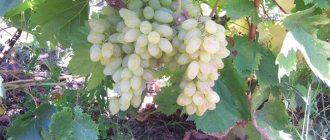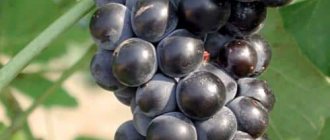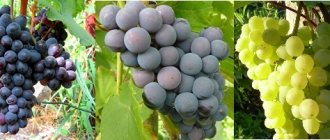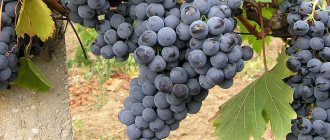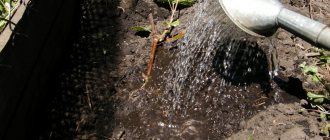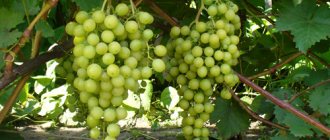Advantages and disadvantages
Pros:
- It takes root well.
- Not prone to peas.
- Frost resistance.
- Versatility.
- Early ripening.
- Self-pollinating.
- Pronounced grape taste.
- Unpretentiousness.
Minuses:
- Poor transportability.
- Berries may be susceptible to cracking in high humidity conditions.
- Often damaged by wasps.
- Has average resistance to fungal diseases.
- The berries are not very attractive in presentation.
Origin
“Sphinx” was bred in the south of Ukraine in the city of Zaporozhye by amateur breeder V.V. Zagorulko. This relatively new hybrid form of table grapes was obtained by crossing two well-known varieties: “Strashensky” and “Timur”. The parents of the “sphinx” are “Strashensky” and “Timur”
From its parents, the “sphinx” adopted such qualities as: early ripening, high yields, large dark berries.
Reference! According to the breeder himself, “Sphynx” can be grown very successfully in the south of Russia, Ukraine and Belarus.
Main characteristics
“Sphinx” is an extremely early variety with large round berries, not prone to peas, with a classic grape taste.
Ripening period
“Sphinx” belongs to the very early varieties. From the moment the buds swell in early spring until the harvest ripens, about 100-105 days pass. The ripe harvest can be harvested as early as mid-August.
The early maturity of the fruit is not at all hampered by the fact that bud burst in this variety begins quite late. Later swelling of the buds and flowering protects the crop from returning spring frosts , which occur especially often in central Russia.
Bush
The cuttings take root well and are perfectly compatible with rootstocks. The vine grows quickly and ripens early along its entire length. The bushes are vigorous with strong branches and a strong trunk.
The leaves are large and medium-dissected. Thanks to bisexual flowers, the gardener does not need to worry about additional pollination, because... the plant is self-pollinating.
In the fall, it is necessary to prepare the vine for wintering. To do this, cut off all unnecessary shoots and trim the main ones, giving the shape to the vine. For the “sphinx”, a fan shape of the bush is suitable. This formation of the vine makes it easier to process and cover the grapes for the winter. The fan arrangement of the shoots also ensures good lighting and ventilation of the bushes.
bunches
“Sphinx” is not prone to peas under favorable growing conditions. But during periods of prolonged rain, when the humidity is especially strong, gardeners often face this problem. To protect the grapes from excess liquid, water is diverted from the bushes, for example, by covering the bottom of the vine with pieces of slate.
The clusters are cylindrical-conical in shape, with a low density of berries on them. Quite large, weighing from 800 g to 1 kg.
Berries
The variety is notable for its large, round berries. The fruits reach a diameter of 3 cm and weigh from 8 to 10 grams.
The skin of the berries is dense, when fully ripe it acquires a beautiful dark blue color, and is covered with a light waxy coating on top. The pulp is crispy and juicy, contains up to 3 medium-sized seeds, which are quite noticeable when tasting.
The sugar content of the berries of this variety is variable and depends on the number of sunny days. In the warm and sunny season, fruits gain sugar up to 25%. The acidity of the berries is at the level of 5-6 g/l.
Taste
The taste is pronounced, grape, characterized by simplicity, harmony and slight sourness.
There are no special notes in the taste and aroma. Although, some winegrowers note a peculiar aroma and some marmalade of the berries.
Reference! The taste of the berries improves over the years as the vine grows wood.
Variety care
Sphinx grapes need constant watering, which includes fertilizing, pruning, protection from diseases and pests. In cold regions, bushes are covered for the winter.
Watering
Young plants no more than 3 years old need regular watering. They are watered through a drainage pipe according to a certain scheme:
- in early spring after removing the cover;
- during the formation of buds;
- after flowering ends.
The water consumption for each Sphinx bush is 4 liters. The moisture is first settled in barrels, where it must be warmed in the sun or in a greenhouse. Watering the grapes is combined with fertilizing. Add 200 g of wood ash to the water.
Mature grapes are not watered during the season. Moisture must be added in the fall before covering. Pre-winter watering prevents the crop from freezing.
Feeding
When using fertilizers for a planting hole, plants are provided with useful substances for 3-4 years. In the future, Sphinx grapes are regularly fed with organic matter or mineral components.
For the first fertilizing, which is carried out after removing the cover from the grapes, nitrogen fertilizer is prepared. Organic substances used include chicken manure or slurry. Grapes react positively to the addition of 30 g of ammonium nitrate to the soil.
Before flowering begins, the treatment is repeated with the addition of 25 g of superphosphate or potassium sulfate. It is better to avoid nitrogen components during flowering and ripening of berries, so as not to provoke excessive growth of green mass.
When the berries begin to ripen, the grapes are fed with superphosphate (50 g) and potassium sulfate (20 g). Substances are embedded in the soil during loosening. In the fall, after harvesting, wood ash is added to the soil.
Trimming
Proper formation of the grapevine ensures a good harvest of the crop. Sphinx grapes are pruned in the fall to cover for the winter. 4-6 eyes are left on the shoot. With increased load, the yield decreases, fruiting is delayed, and the berries become smaller.
The Sphinx grape bushes are formed in a fan fashion; it is enough to leave 4 sleeves. The variety is not prone to the formation of stepson clusters.
In summer, the leaves above the clusters are torn off so that the berries receive more sunlight. In spring, pruning is not carried out, since the vine produces “tears”. As a result, the plant loses its harvest or dies. After the snow melts, only dry and frozen shoots are removed.
Related article: Grape variety 1-8-6-1
Protection from diseases and pests
The Sphinx variety is characterized by high resistance to oidium and mildew. The diseases are fungal in nature and spread due to non-compliance with agricultural practices, excessive humidity, and lack of care.
According to reviews, Sphinx grapes are not susceptible to gray rot. To protect plantings from diseases, preventive treatments are carried out: in early spring, before flowering and after harvesting. Plantings are sprayed with Oxyx, Topaz or any other preparations containing copper. The last treatment is carried out 3 weeks before harvesting the grapes.
The vineyard is affected by wasps, borers, mites, leaf rollers, thrips, phylloxera, and weevils. To get rid of pests, special preparations are used: Karbofos, Actellik, Fufanol.
Healthy plants are treated in late autumn with a solution of the drug Nitrafen. Take 20 g of substance per 1 liter of water. After spraying, they begin to prepare the crop for winter.
Shelter for the winter
The frost resistance of the Sphinx variety is quite low, so it is recommended to cover the plantings in winter. The grapes can withstand temperatures up to +5 °C. When a more serious cold snap begins, they begin to cover the bush.
The vine is removed from the supports and placed on the ground. The bushes are hilled up and covered with mulch. Arcs are installed on top, onto which agrofibre is pulled. Be sure to ensure that the grapes do not rot.
Features of cultivation
“Sphinx” is undemanding in terms of agricultural technology. It is easy to grow even for a novice winegrower. Caring for the vine is simple and meets all the basic requirements for cultivating cover grape varieties.
Landing
Grapes are planted in the spring from April to mid-May or in the fall - in October. Before planting, the seedling must be prepared. To do this, the young plant is kept in water for 1-2 days. Next, it is cut off, leaving 2-3 buds and planted in a hole 80 cm deep and wide.
The distance between plants should be at least 2 meters. At the bottom it is necessary to place organic fertilizers, manure or compost, as well as potassium and superphosphate fertilizers. After which the seedling is placed in a hole, its roots are straightened and covered with earth. At the end of planting, each plant must be watered generously, about 2 buckets per bush.
Place and soil
One of the serious disadvantages of the “Sphinx” is its strong fear of drafts. Given this feature, many gardeners grow it in greenhouses, where it also grows and bears fruit well. But even in open ground, the hybrid can feel quite comfortable. To do this, you just need to choose the most suitable place, protected from the wind.
It is advisable to plant grapes next to the wall of a house, a blank fence, bushes or trees. So that on those sides the vine is protected from cold winds, and on the fourth it is well illuminated by the hot rays of the sun.
Like other grape varieties, it is important for “Sphinx” that the soil has good air and moisture permeability. The composition of the soil is not particularly important. The main thing is that the place is not very swampy. Some gardeners note that on sandy soils the berries ripen sweeter.
Watering and fertilizing
Throughout the season, the “Sphinx” needs regular feeding. Organic matter (manure, compost) and mixtures containing phosphorus, nitrogen, potassium and zinc are used as fertilizers. During the growing season, it is necessary to carry out at least 3 feedings at intervals of 3 weeks.
Important! Pay attention to the condition of the grape bushes. Excess fertilizers also negatively affect the plant, as does their lack.
Bushes need good moisture. Particularly abundant watering is required before flowering, after the formation of clusters and during very dry periods. For each adult bush you need to gradually pour about 4 buckets of water.
Watering is stopped about a week before flowering begins. Excessive moisture at this time can cause buds to drop and slow down the ripening of the crop.
To make watering more convenient, you can organize one of the irrigation systems. Most often, drip structures are installed or drainage pipes are dug into the ground.
To reduce moisture evaporation, the soil under the bush is mulched. For mulching they use: sawdust, mown grass, straw, tree bark, spruce branches and various other natural or synthetic materials.
Trimming
With proper formation of the vine, productivity increases and the care of the bushes becomes easier. If the bush is very thick and the load on it is large, then fewer ridges are formed and the berries become smaller.
The “Sphinx” grape variety is formed using a standardless fan method with 4 sleeves. Pruning is done in the fall after the leaves have completely fallen. This variety is not prone to the formation of stepchildren, so it is quite easy to prune. It is enough to leave 4 strong shoots, which are located on different sides of the trellis and trim them to 4-6 eyes.
Subsequently, before wintering, each vine is cut to the height of mature wood.
It is recommended not to prune grapes in spring, especially if you are an inexperienced winegrower. Because due to the sap flow that has begun, the plant may weaken. During this period, only frozen and dry shoots can be removed.
Diseases and pests
“Sphinx” has average resistance to disease. If agricultural cultivation techniques are not followed, grapes can be affected by fungal diseases such as oidium and mildew. And also be attacked by insects. The main pests of grapes: phylloxera, leaf rollers, spider mites.
To protect the vineyard from diseases, preventive treatment with drugs is carried out twice a year. The first spraying is carried out in early spring, before flowering begins. The second is after harvesting.
Fungicides are used against fungus: Topaz, copper sulfate, etc. Insecticides protect against harmful insects: Karbofos, Actellik, etc.
Due to the high sweetness of the berries, it can also be attacked by bees. In large numbers, these insects can cause significant damage to the crop. To protect the grapes from them, the bushes are covered with a fine mesh net or nylon tights are put on each bunch.
A simpler and accessible way at any time is to place containers with sugar syrup to which an insecticide has been added near the bushes.
Preparing for winter
“Sphinx” can withstand frosts down to -23ºС. When growing grapes in regions with a cool climate, they must be covered for the winter. In October, after all the leaves have fallen, the bushes are pruned. The vines are laid on boards or sawdust laid out along the beds. A layer of sawdust, leaves or hay is poured on top and covered with film.
Important! The grapes need to be covered before the first frost. Do not wait until the temperature drops below +5ºС.
On sunny days before frost sets in, the shelter can be opened slightly to prevent the vines from overheating.
Winter shelter option
Harvest storage
The harvest does not last long on the bushes. Therefore, as the berries ripen, they must be removed immediately, otherwise they will quickly wither. Although, some gardeners like these dried berries, which become sweeter due to loss of moisture.
The harvested “Sphinx” crop does not last long. If whole bunches are kept in a cool, dry room, its shelf life is no more than 1 month. Due to its short shelf life, these grapes are recommended to be consumed fresh or used for making raisins and various preparations for the winter. “Sphinx” makes excellent juices, compotes, jam and homemade table wine.
Regions
“Sphinx” is a fairly frost-resistant variety, thanks to which it is safely grown not only in the south of Russia, but also in cool mid-latitudes: the Moscow region, the Volga region.
However, it is worth remembering that this hybrid belongs to the covering varieties, so in order to preserve the vineyard, it is necessary to take care of insulation in advance. Otherwise, winter frosts will not only damage the shoots, but can also destroy the entire plant.
Step-by-step planting instructions
The good development of the bush and its productivity depend on the correct choice of site for planting and cultivation. It is preferable to plant seedlings in spring - the plant has time to get stronger and prepare for wintering.
The area should be well lit by the sun throughout the day. It is not recommended to plant grapes next to fruit trees - they “take away” nutrition from the vine. The optimal distance to trees is 4-5 meters.
Low-lying areas that are flooded with meltwater in the spring are not suitable for growing the Sphinx. If there is no choice, then you can make an artificial embankment and drainage system. Heavy soil is improved with sand (preferably not quarry sand, but river sand!), peat, and humus.
The planting pit is prepared 2-3 weeks before planting. Its dimensions should be quite large: diameter at least 0.8 m, depth - 60-70 cm. Expanded clay, crushed stone, and crushed brick are poured into the bottom as drainage. Many gardeners advise placing a piece of pipe with a diameter of 10 cm vertically in the hole for watering.
Mineral (potassium sulfate, superphosphate) or organic (wood ash, compost) fertilizer is added to the soil with which the hole is filled. The hole is left for the soil to shrink. When planting, add fertile soil and plant the seedling, watering it abundantly. It is advisable to fill the hole with mulch.
Comparison with analogues
Vitaly Vladimirovich Zagorulko has achieved high results in 15 years of breeding work. His hybrid forms have become famous and take prizes at international exhibitions.
The goal of Zagorulko selection is to develop grape varieties distinguished by large berries, excellent presentation and excellent taste.
“Sphinx” cannot boast of high product characteristics. But thanks to its extremely early ripening period, it is highly valued because... one of the first to appear on the market. Let's consider it in comparison with the main ultra-early competitors.
| Sign | Variety | |||
| Sphinx | Elegant | Super extra | Veles | |
| Ripening period | 95-105 days | 95-105 days | 95-105 days | 100 - 110 days |
| Frost resistance | Up to -23 °C | Up to -25 °C | Up to -25 °C | -23C |
| Yield per bush | 30 kg | 15-20 kg | Up to 25 kg | 30-50 kg |
| Bunches | 500-700 g | 400-500 g | 500-800 g | 600 g – 2 kg |
| Taste | Sweet with a bright nutmeg aroma | Harmonious | Simple, moderately sweet | Muscat |
| Color | Dark blue | Yellow | Green-yellow with amber tint | Pink - amber |
| Disease resistance | High | High | Average | Above average |
| Shelf life | About 1 month | up to 1 month | A few months | Up to 3 months |
| Sugar content | Up to 25% | 20-22% | 17,40% | 17 – 22% |
| Acidity | 5-6 g/l | 4-5 g/l | 6.1 g/l | 5 - 7 g/l |
“Sphinx” is certainly worthy of growing in garden plots. Its unpretentiousness and ease of care allows even novice winegrowers to get a good harvest.
Productivity of the Sphinx
The yield of this table variety with proper care and favorable climatic conditions reaches up to 8-12 kg per vine. The indicators are average, but the variety produces stable yields every year. The bunches weigh 600-800 grams, the record weight can reach 1.5 kg. The bunches ripen well even with a high yield.
There are almost no undeveloped berries in a bunch; cold, rainy weather produces peas in rare cases. Mature brushes can hang on the branches for at least 2 weeks without compromising their taste or appearance. The first clusters will form in the second year after planting. And in another year the vine will delight you with its first full harvest.
Mature clusters are cut selectively - in the sun they ripen faster, on shaded branches a little later. The harvest can be stored in a cool place for 10-14 days after cutting - the berries retain their turgor, taste and presentation. Transportation must be organized carefully and carefully. Resistance to it is average.
Reviews
Sphinx is an ordinary variety, not very early, as stated. the taste is simple but sweet. Vladimir, Tiraspol
The taste is good, no frills. The cluster is large, the berries are large and round. Elena Petrovna, Rostov region.
Sphinx is a bisexual variety, pollinates well, and has good disease resistance. But I don’t really like its taste (marmalade) and besides, it doesn’t hang on the bush for very long. It’s just ripe and needs to be cut right away. Irina Alexandrovna, Nikopol
